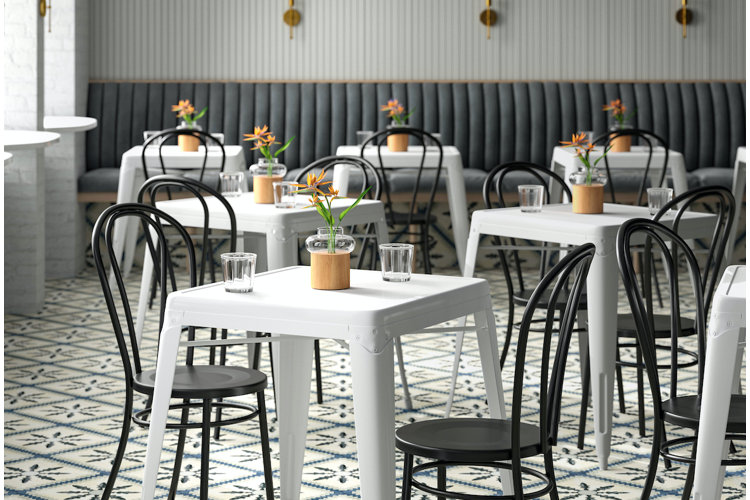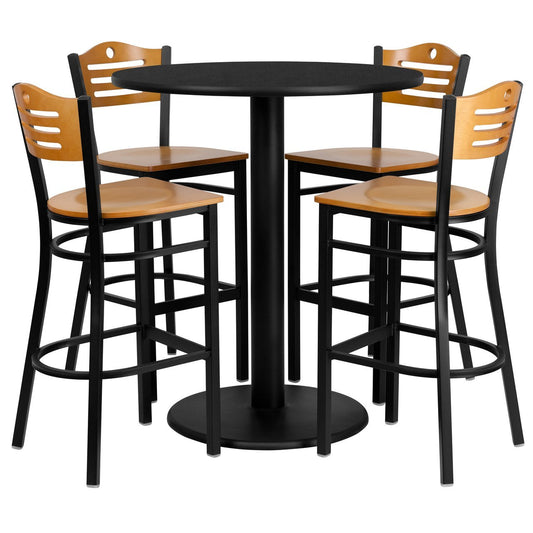
Cafe Table Buying Guide: Find the Perfect Fit for Your Space
Share

There are many factors that you are required to consider when procuring the most appropriate cafe table to ensure that your patrons feel comfortable in your facility. Being able to understand the size, the material, the design, and the functionality of a cafe table is vital in choosing the correct table set to complete and enhance your space, as well as providing comfort to your guests.
In this informative guide, we’ve outlined everything you need to know on how to select the best cafe tables, including types of table materials used, sizes, and design considerations. Whether your business requires a small corner for serving coffee or a large restaurant, you’ll find something suitable here.

23.75'' Square White Metal Indoor
With its simple lines and bright color, this indoor-outdoor metal bar height table is sized right for small spaces. Compact in design, the table top is 23.75 inches square and has a 2 inch lip with rounded corners. The legs extend to 27.75 inches in width at the base.
1. Understanding the Purpose of Your Cafe Table
When it comes to your cafe tables, it is imperative to have an understanding of what you intend to use the tables for. Do you wish to equip an interior or exterior work? Are you looking for communal tables, or are you designing for intimacy and seclusion? Such questions can help you to navigate and find the proper decisions for your business.
Key Questions to Ask:
- Is your cafe a high-traffic area? Select such materials that are more durable and easy to wash and clean.
- Are you looking to maximize seating? One has to opt for small tables so that they can cater to many people.
- Do you want a specific aesthetic? The type of tables that you should select should complement your overall décor in the interior space.
2. Cafe Table Sizes: What Fits Your Space?
Tables that are used in the cafe are varying sizes that fit certain spaces or functions. The size you choose should be harmoniously blended into the interior layout of your store, and still provide adequate space for the customers to sit comfortably while they eat.
Standard Cafe Table Sizes
- Small Café Tables (24-28 inches): Perfect suitable for small areas, or when designing a couple of seats.
- Medium Cafe Tables (30-36 inches): They are an interesting and variable option for mid-sized cafés that suit both practicality and capacity.
- Large Cafe Tables (42 inches and up): : Especially suitable for cases where customers may be admitted in groups in the facility.
Table Height
The ideal average height of a cafe table is normally set at a height of 28-30 inches. This makes it comfortable to have a dining experience if it is accompanied with regular metal stools or cafe chair.
3. Materials: Durability Meets Style
When it comes to the use of material in the construction of the cafe table several factors must be considered including durability, appearance, and ‘cleanability’. Here are some popular options to consider:
Wood
Using wooden cafe tables warms up any cafe, and gives it a classic look to attract more customers. They are suitable for interiors but can be treated for exterior too. Make sure that the wood is protected against water and other stains.
Metal
A metal table has a contemporary and rather elegant appearance and is one of the hardest-wearing types of table available. They are quite employed in the industrial or minimal cafe appearance. Those made in aluminum or stainless steel would be the most appropriate to be used on the outside since these materials do not get easily rusty.

23.75'' Square Yellow Metal Indoor-Outdoor Bar Height Table
With its simple lines and bright color, this indoor-outdoor metal bar height table is sized right for small spaces. Compact in design, the table top is 23.75 inches square and has a 2 inch lip with rounded corners. The legs extend to 27.75 inches in width at the base. The table features a cross-brace that provides increased support and stability
Glass
If you need something more elegant and classy for your cafe then a glass tabletop is the perfect solution for your cafe. But, these can laminate quickly and show fingerprints and stains hence they need more maintenance. They are best suited in classy or specialist coffee shops.
Composite Materials
Laminated and veneered furniture may look like furniture made of wood or stone, but it will cost much less and does not require special care. High traffic areas are ideal to be fitted with these designs since they do not cost much and are very strong.
4. Cafe Table Shapes: Round, Square, or Rectangular?
The choice of your cafe tables influences both utility and design aspects of your business interior. The right shape for your table can make or break your seating arrangement and the comfort of your guests.
Round Cafe Tables
These are meant for surrounding dining, and as such will foster increased communication and interaction among people. They also suit small spaces because they do not have sharp edges. Still, they are not the most effective solutions to achieve large numbers of seats.
Square Café Tables
Square tables are relatively flexible and can accommodate several individuals as well as large groups. You can easily align it in rows or clusters depending on how you want to organize them depending on the amount of space that is available. However, they can contribute to promoting interaction differently from round tables.
Rectangular Café Tables
The rectangular shape proves convenient in accommodating many people and is suitable for cafes that are spacious enough. It can either be fitted around the edges of a room or arranged in a straight line in a manner, that resembles the arrangement of banquet tables.
5. Maximizing Comfort and Functionality
When deciding where to put the cafe table, customers’ comfort, and practicality should be considered. Here are some key considerations to keep in mind:
- Table Stability: Choose a table base that is stable and has good balance, especially in an open area where the ground is never level yet you have your table uneven.
- Easy Maintenance: They should be easy-to-clean materials to ensure that you can wash and maintain them frequently because guests are always coming and going throughout the day.
6. Design and Aesthetic Considerations
Cafe tables should blend with the overall design of the place and also assist you in the achievement of your intended ambiance. Here are some design aspects to consider:
Matching the Décor
While choosing your tables you should bear in mind the style of your cafe, whether its theme is rustic or industrial, minimalist, or contemporary. Small wooden tables will blend well in a country-style interior whereas metal or glass tables are perfect for a modern home.

24'' Square Mahogany Laminate Table Top with 22'' x 22'' Table Height Base
Complete your restaurant, break room or cafeteria with this table top and base configuration. This set is designed for Indoor Indoor Commercial Use to withstand the daily rigors in the hospitality industry. This set will also make a great option for your home as a dining table or in the rec room.
Customization
It is also very advisable to ensure that your tables reflect a copy of what your brand or logo looks like. This could be the function of adding subliminal patterns, color, or even finish to agreed styles to develop a harmonized atmosphere of brand style.
7. Cafe Table Care and Maintenance
Well cared for and maintained, your cafe tables will look as good as the day they were installed and will not require replacing for many years.
Tips for Table Maintenance:
- Wooden Tables: They can be cleaned with a damp cloth and must be polished often to retain their finish.
- Metal Tables: These should be wiped gently with a piece of cloth and some gentle soap to reduce cases of rust and corrosion.
- Glass Tables: To remove stains and other obscure marks on the surface one can use a glass cleaner.
Conclusion
In summary, the selection of the right cafe table is important to ensure that effectiveness, comfort, and aesthetics are met. It is important to pay attention to the size, height, material, shape, and design of the tables so that they complement the dining establishment space and also offer satisfaction to the customers. When you are furnishing a cafe, getting the right type of cafe table is all about whether you want it to give off a romantic and close-knit atmosphere, or whether it should be a place where as many people can be seated as possible.
With this guide from Wholesale Bar Stool Club, you will be in the right position to make the right decision whenever you are choosing your cafe tables for a perfect fit for your space.

24'' Square Natural Laminate Table Top with 22'' x 22'' Table Height Base
Complete your restaurant, break room or cafeteria with this table top and base configuration. This set is designed for Indoor Indoor Commercial Use to withstand the daily rigors in the hospitality industry. This set will also make a great option for your home as a dining table or in the rec room.
FAQs about Cafe Tables
1. How high is a cafe table?
Cafe tables are usually between 28 – 30 inches in height to allow easy sitting and dining while at the table.
2. How much space should be between cafe tables?
To allow freedom of movement and comfort, there should be roughly a minimum of 24 to 30 inches of gap between the cafe tables. This means that the guests and the staff can navigate around the area without any feeling of congested space.
3. How do I maintain wooden cafe tables?
Wooden cafe tables must be wiped with a damp cloth and could be varnished occasionally to retain their finish. One must ensure that the surface isn’t exposed to humidity or high temperatures that will bring about warpage or otherwise damage.
4. How to make a round cafe table?
To construct a round cafe table, round table top material such as wood or metal, cutting a round table top from the material selected for the tabletop, and fixing it to a round table base. For a fitted couch, make sure the dimensions are proportional to the area where it is to be placed.
5. What materials are best for outdoor cafe tables?
When it comes to choosing the correct table for an outside cafe, metal, treated wood, or plastic materials are the right ones to select since they’re long-lasting and simple to clean. These types of metals are quite resistant to rust and corroding including aluminum and stainless steel.




